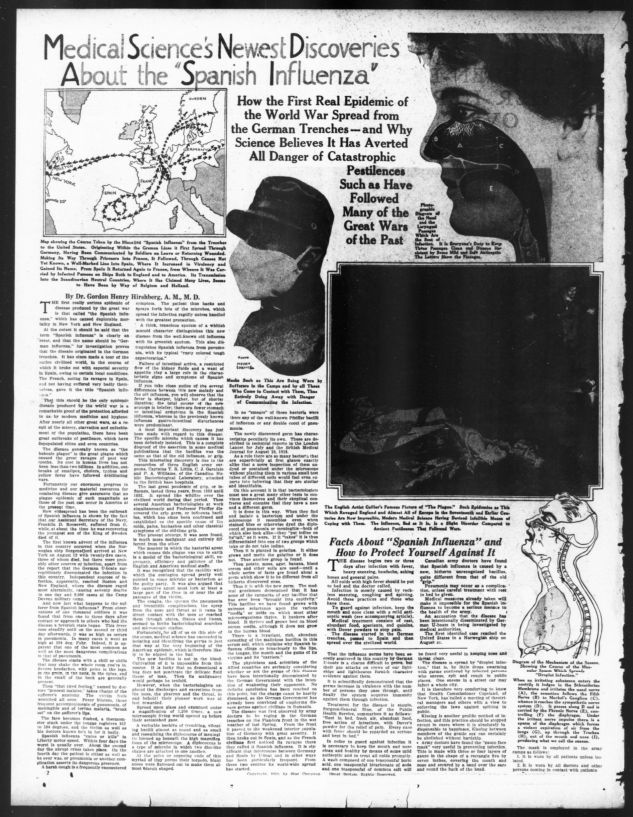The “Spanish Influenza” was a virus that “quickly spread around the globe and altered the course of world history” as it took more lives than the Great War.((Gordon H. Hirshberg, “Medical Science’s Newest Discoveries about the ‘Spanish Influenza’.” The Washington Times. NATIONAL EDITION, The American Weekly Section, Image 22, October 06, 1918 https://chroniclingamerica.loc.gov/lccn/sn84026749/1918-10-06/ed-1/seq-22/#words=influenza+Boston+Influenza+military.)) During this time period from 1918 to 1919, it was very common for diseases to arise during wartimes, and this flu grew to be the deadliest disease.((Kathleen M. Fargey, “THE DEADLIEST ENEMY: The U.S. Army and Influenza, 1918–1919.” Army History, no. 111 (2019): 24–39. https://www.jstor.org/stable/26616953.)) This piece, “Medical Science’s Newest Discoveries about the ‘Spanish Influenza'”, by Dr. Gordon Henry Hirshberg, A.M., M.D. was published on October 6, 1918, in the Washington Times. It discusses the medical discoveries made during this time period with the “Spanish Influenza”, one of the most prominent discoveries being the isolation of the microbe that causes it. ((Hirshberg 1918.)) He identifies key symptoms to differentiate the disease from others such as “thick, tenacious sputum of a whitish mucoid character”, as well as fever that is “sharper, higher, but of shorted duration”.((Ibid.)) Hirshberg also discusses how although it is named the “Spanish Influenza”, it actually originated from Germany. It was believed that the flu originated in the German trenches, then moved into Spain, then into France, and then it made its way to the United States. America had made many medical advancements enabling us to prevent epidemics of high magnitude to affect us as much as they had in the past, but this influenza in particular had mortality rates ranging from 4.4% to 6.3%.((Fargey 2019, 33.)) Dr. Hirshberg discusses the progression of the disease and how quickly it would “cure or kill”.((Hirshberg 1918.)) According to Dr. Hirshberg, the infection was a droplet infection and would spread rapidly, so the use of gauze face masks was necessary.((Ibid.))
Throughout this time, America was considered the strongest world power. Dr. Hirshberg explains that America wasn’t even hit as hard as other countries by the Spanish Influenza, due to the science that allowed us to identify the germ early in the epidemic, which he explains a few months after the flu came to the United States.((Ibid.)) Although America was a strong world power, there were still internal issues going on within the United States due to the toll the Great War took on it. America had entered the war in April 1917. Washington, for example, was then flooded with war workers, which led to housing shortages and inevitable spikes in rent.((Amanda Huron, “Defending Tenants in the Midst of Plague.” Washington History 32, no. 1/2 (2020): 41–43. https://www.jstor.org/stable/26947516.)) The pandemic was just another thing added on to everything else going on in the United States. The influenza led to closures of schools, churches, saloons, and theaters, as well as the opening of hospitals.((Christina M. Stetler, “The 1918 Spanish Influenza: Three Months of Horror in Philadelphia.” Pennsylvania History: A Journal of Mid-Atlantic Studies 84, no. 4 (2017): 462–87. https://doi.org/10.5325/pennhistory.84.4.0462.)) The flu was quick and deadly, and war workers living in tight spaces were even more likely to transmit the disease.((Huron 2020, 42.)) Although the flu ran rampant throughout the United States, we handled it better than most, and it seems that the epidemic “receded from collective memory and largely forgotten… of World War I”.((Stelter 2017.)) Dr. Hirshberg explains how the Spanish Influenza led the United States to develop even more medical advances, this way a flu with this magnitude could never happen again in America.
The Spanish Influenza was so much worse than the past epidemics experienced during or post-war. America did have more medical discoveries, so we were able to work through it more quickly, but there were still numerous fatalities with approximately 675,000 deaths.((David E. Shi, 2022. America: A Narrative History. 11th ed. New York: W. W. Norton & Company.)) This flu was just another thing to hit the United States. There were already struggles due to the war from the influx of people who came to the United States to get wartime jobs. Dr. Hirshberg discusses the disease itself and the symptoms that affected everyone. It was highly contagious, as well as extremely fatal.
Spanish Flu Newspaper Article
1900-1920, 20th Century